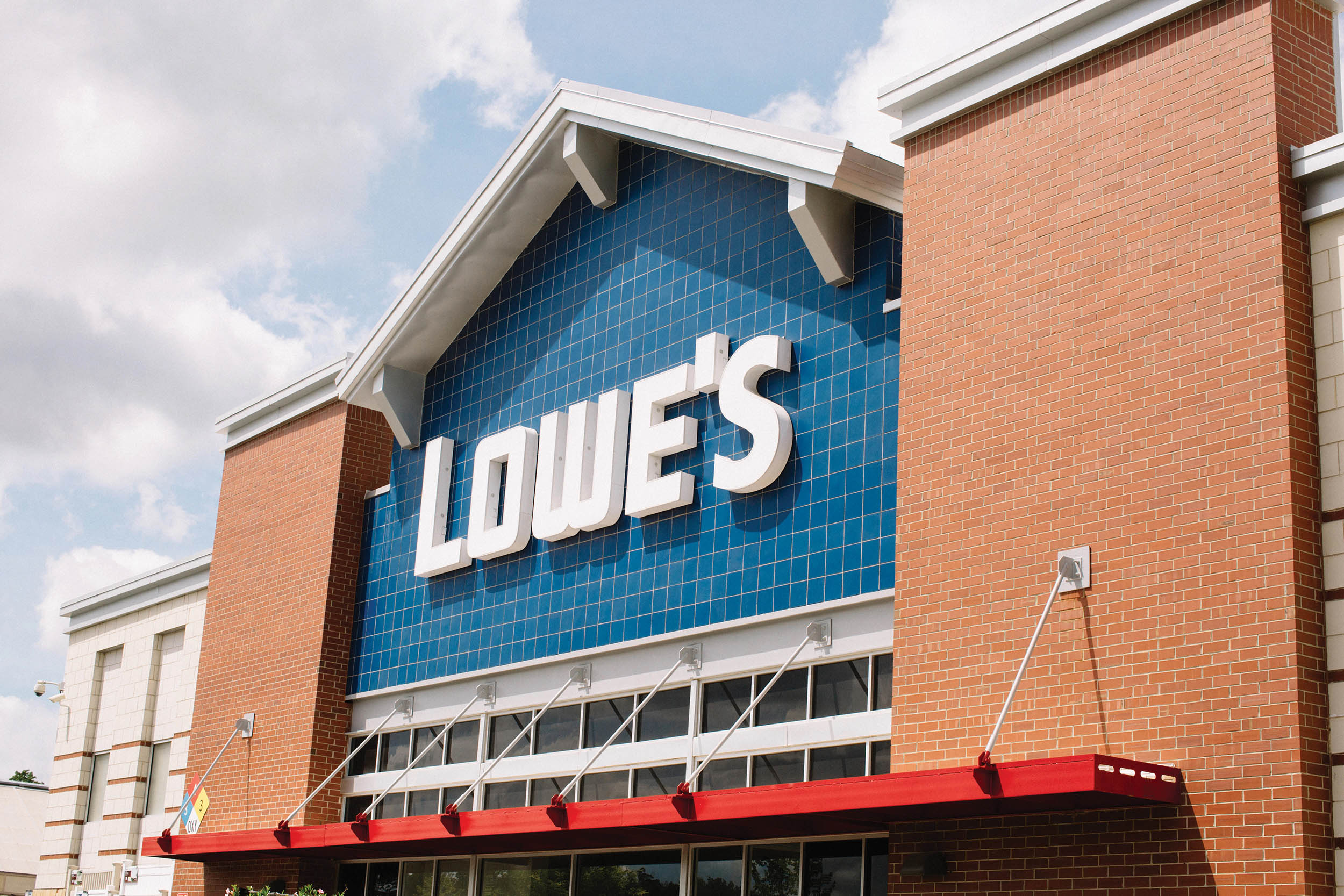— By Meg Mason —
How Lowe’s has reduced water use and its carbon footprint with smart irrigation.
Lowe’s is focused on reducing its environmental impact while also increasing the efficiency of its operations. To address these goals, Lowe’s installed HydroPoint smart irrigation controllers to optimize landscape irrigation at more than 900 of its stores. Each year, the controllers reduce water use at these facilities by about 650 million gallons, saving Lowe’s an estimated $5 million in total water costs.1 Because water treatment and pumping use a lot of energy, saving 650 million gallons of water also effectively reduces community greenhouse gas (GHG) emissions by an amount equal to burning 84,000 gallons of gasoline.2
Challenge: Reduce Retail Store Environmental Footprint & Operational Costs

Meg Mason, HydroPoint
Since 1946, Lowe’s grew from one hardware store in North Carolina to a Fortune® 50 company with thousands of home improvement stores in the United States, Canada and Mexico. Lowe’s is committed to reducing its environmental impact through product sustainability and operational excellence. In addition to offering a number of eco-products that help customers reduce their impact on the environment, Lowe’s promotes sustainable practices through its chain of retail stores. Among the areas of focus are the reduction of greenhouse gas emissions (GHG) and water use.
Lowe’s recognizes that highly efficient landscape irrigation could address both of these goals. Not only does efficient irrigation optimize water use, but it also comes with a GHG benefit because most potable water is treated and pumped before it is used, a process that is energy intensive. As a result, a more efficient irrigation system that uses less water also reduces energy use and associated GHG emissions.
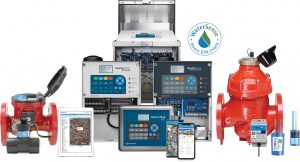 “We worked with our sustainability team to identify smart investments that would increase our efficiency while also reducing our environmental impact,” says Jay Clement, Lowe’s director of facilities. Recognizing that 50% of the water used for irrigation is wasted because of evaporation, wind or inefficient irrigation methods3, Lowe’s began evaluating landscape irrigation solutions.
“We worked with our sustainability team to identify smart investments that would increase our efficiency while also reducing our environmental impact,” says Jay Clement, Lowe’s director of facilities. Recognizing that 50% of the water used for irrigation is wasted because of evaporation, wind or inefficient irrigation methods3, Lowe’s began evaluating landscape irrigation solutions.
Solution: HydroPoint Smart Irrigation to Reduce Environmental Impact & Drive Efficiency
HydroPoint stood out as a premier partner based on the results of more than 25 public and private studies and its longevity in the smart irrigation business. In business since 2002, HydroPoint solutions have achieved 95% of conservation potential while reducing water use by between 16% and 59%. HydroPoint uses AT&T (IoT) cellular technology in its smart irrigation systems to transmit detailed weather data, which is used to calculate the optimal amount of water needed for irrigation, keeping plants healthy.

 Every day, the HydroPoint Climate Center analyzes over 8 million weather data points from around the world, including over 50,000 U.S. weather stations and hundreds of thousands of other data sources. This precise weather data, specifically temperature, wind, humidity and solar radiation, are combined to generate customized evapotranspiration (ET) values. Originally used in the agriculture industry, ET is a highly accurate way to calculate landscape water needs and it is the primary indicator that HydroPoint uses to control irrigation. Many other irrigation controllers on the market only use temperature to determine irrigation patterns, which can overwater the landscape by as much as 43%.4
Every day, the HydroPoint Climate Center analyzes over 8 million weather data points from around the world, including over 50,000 U.S. weather stations and hundreds of thousands of other data sources. This precise weather data, specifically temperature, wind, humidity and solar radiation, are combined to generate customized evapotranspiration (ET) values. Originally used in the agriculture industry, ET is a highly accurate way to calculate landscape water needs and it is the primary indicator that HydroPoint uses to control irrigation. Many other irrigation controllers on the market only use temperature to determine irrigation patterns, which can overwater the landscape by as much as 43%.4
Implementation: Lowe’s Selects HydroPoint to Reduce Water Use, Building Operation Costs & Emissions
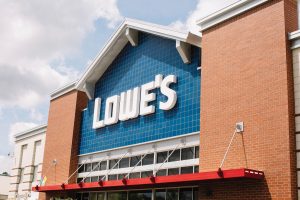 Lowe’s installed HydroPoint smart irrigation systems at more than 900 of their retail facilities. So far, the controllers have reduced water use by about 650 million gallons annually, saving the company almost $5 million in total water costs. Because most Lowe’s stores use water from their local municipality, the company created annual downstream greenhouse gas emissions savings of about 750 metric tons CO2e, which is comparable to over 84,000 gallons of gasoline.2
Lowe’s installed HydroPoint smart irrigation systems at more than 900 of their retail facilities. So far, the controllers have reduced water use by about 650 million gallons annually, saving the company almost $5 million in total water costs. Because most Lowe’s stores use water from their local municipality, the company created annual downstream greenhouse gas emissions savings of about 750 metric tons CO2e, which is comparable to over 84,000 gallons of gasoline.2
Sustainability Impact: Recognizing the Potential Impact of HydroPoint Smart Irrigation
The wide adoption of HydroPoint smart irrigation can have substantial environmental benefits. If 2,000 retail stores in the United States use HydroPoint to increase the efficiency of their irrigation, water use could be reduced by almost 1.4 billion gallons and GHG emissions by 1,590 metric tons.2
Sidebar:
Saving Water: A Win-Win
Water conservation is a win-win for businesses and the environment.
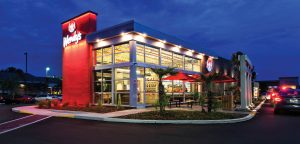
Image courtesy of The Wendy’s Company
As climate conditions grow more extreme and water becomes scarcer, businesses of all kinds will have to identify ways to better conserve water and eliminate water wasting practices. This is true for the retail and restaurant sector, which account for 15% of the total water use in commercial facilities in the U.S. Water is a necessary part of the restaurant business, especially in the food preparation process, restrooms and landscaping. Luckily there are solutions to not only save water, but also reduce operating expenses and eliminate potential headaches or brand damage.
Restaurants can reduce their water use by installing equipment that actively conserves water. Installing this sort of equipment in commercial facilities can decrease operating costs and energy and water use. For example, Wendy’s® has utilized new automated dishwashing equipment that reduces the average water use by 47% per cycle. Replacing existing products with more efficient models is also an effective way to save money and reduce water use.
Another option for water conservation is to ensure low-flow toilets are installed in all restrooms. Most toilets are low-flow toilets, but in older facilities, it is possible that older toilets have not been replaced. Low-flow toilets are any toilet purchased after 1994 and are easily identifiable by a stamp or sticker that indicates the gallons per flush. A running toilet will use more than 200 gallons per day, potentially increasing water costs by 10%. Installing the newest type of toilet will help conserve water and save money.
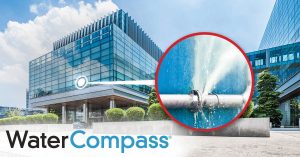 Leak detection technology can also help alleviate water waste from restrooms. For instance, WaterCompass from HydroPoint uses real-time flow-monitoring IoT sensors and analytics to provide water use visibility across an entire site. WaterCompass enables restaurant site owners and facility managers to overcome the systemic “water blindness” that plagues properties, by sensing leaks and breaks, notifying appropriate team members as they happen so that water use anomalies can be solved as quickly as possible. Even the smallest leak can waste 100,000 gallons and $18,480 in water, sewer and gas costs, so having leak detection in place can prevent major water events from occurring.
Leak detection technology can also help alleviate water waste from restrooms. For instance, WaterCompass from HydroPoint uses real-time flow-monitoring IoT sensors and analytics to provide water use visibility across an entire site. WaterCompass enables restaurant site owners and facility managers to overcome the systemic “water blindness” that plagues properties, by sensing leaks and breaks, notifying appropriate team members as they happen so that water use anomalies can be solved as quickly as possible. Even the smallest leak can waste 100,000 gallons and $18,480 in water, sewer and gas costs, so having leak detection in place can prevent major water events from occurring.
Beyond leak detection technology, smart irrigation systems can also help with water conservation by improving water use efficiencies. The EPA estimates that nearly 50% of water used in irrigation is used inefficiently. Smart irrigation systems solve for inefficient practices as it identifies the optimal time and amount of water needed for irrigation, while keeping landscapes and plans healthy. Unlike traditional preset irrigation timers, smart irrigation controllers monitor weather, real-time soil conditions, evaporation and plant water use needs to calculate new watering schedules daily automatically.
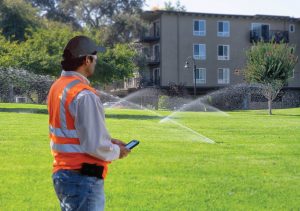 Wendy’s has implemented HydroPoint’s WeatherTRAK irrigation system at some of its locations as a pilot program to ensure that the restaurants are using water more efficiently for landscaping needs.
Wendy’s has implemented HydroPoint’s WeatherTRAK irrigation system at some of its locations as a pilot program to ensure that the restaurants are using water more efficiently for landscaping needs.
Since implementing this technology, Wendy’s has seen a 50% reduction in irrigation water use, while tracking to save more than 1 million gallons of irrigation water in 2021 alone. Continued use of WeatherTRAK will help the company reach its commitment to reduce water use by 20% by 2029.
Consumers are increasingly interested in companies that have made a commitment to reducing their environmental impact. Implementing water conservation solutions is a win-win for a company’s brand image, the bottom line and for our planet’s future.
— Ben Slick, Senior Vice President of Business Development, HydroPoint
Resources:
1 Lowe’s 2017 Social Responsibility Report
2 https://about.att.com/csr/10x
4 Allen, Rick G. The ASCE Standardized Reference Evapotranspiration Equation. American Society of Civil Engineers, 2005. Table F-2: Statistical summary of the comparisons between various reference ET methods, using growing-season results from 82 site-years of daily and 76 site-years of hourly data
— Meg Mason is vice president of marketing for Petaluma, California-based HydroPoint, whose smart water management solutions help companies maximize water savings, reduce operating costs, minimize business risks and achieve sustainability goals. In 2021, HydroPoint managed over 86 billion gallons of onsite water and saved its customers over $119 million in water costs, with a GHG emissions reduction of 367,704 metric tons of carbon dioxide equivalent. For more information, visit www.hydropoint.com.

